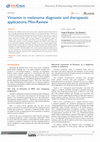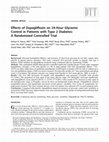Papers by Sergey Zhuplatov

Pharm Pharmacol Int J. 2024;12(6):210‒213, 2024
Melanoma, the deadliest form of skin cancer, poses a significant global health challenge
due to i... more Melanoma, the deadliest form of skin cancer, poses a significant global health challenge
due to its high metastatic potential and resistance to conventional therapies. Vimentin, an
intermediate filament protein typically expressed in mesenchymal cells, plays a crucial role
in various cellular processes, including cell motility, invasion, and metastasis. Different
authors discuss the scientific value of using Vimentin as the diagnostic marker for
invasive types of cancer, including various kinds (oral, hematogenous, amelanotic, etc.)
of Melanoma. Recently, several investigators suggested the possible clinical application
of the monoclonal antibodies inhibiting Vimentin activity for vimentin-targeted tumor-
specific therapy. Another approach could be developing small molecule inhibitors targeting
vimentin or its interacting partners. Authors have found promising results using pannexin 1,
or inhibitors of aPKC and other inhibitors of vimentin activity could reduce tumor growth
in in-vivo experiments. The development of more specific and effective vimentin-targeted
therapies and diagnostic approaches holds significant promise for improving the outcome
of melanoma patients.
Keywords: vimentin, melanoma, skin cancer, epithelial cells, immunohistochemical
markers

Diabetes Technology & Therapeutics, 20(11), 1-10, 2018
Background: Glycated hemoglobin (HbA1c) and measures of short-term glycemia do not fully capture ... more Background: Glycated hemoglobin (HbA1c) and measures of short-term glycemia do not fully capture daily
patterns in plasma glucose dynamics. This study evaluated 24-h glycemic profiles in patients with type 2
diabetes (T2D) initiated on dapagliflozin treatment using continuous glucose monitoring (CGM).
Methods: This randomized double-blind placebo-controlled multicenter parallel-design 4-week study compared
dapagliflozin (10 mg/d; n = 50) with placebo (n = 50) in adult patients with T2D uncontrolled (HbA1c 7.5%–
10.5%) on either stable doses of metformin monotherapy (‡1500 mg/d) or insulin (‡30 U/d with or without up to
two oral antidiabetes drugs). CGM was used to measure 24-h glycemic profiles for 7 days pretreatment and during
week 4 of treatment. The primary outcome was change from baseline in 24-h mean glucose (MG) at week 4.
Results: The 24-h MG decreased 18.2 mg/dL with dapagliflozin and increased 5.8 mg/dL with placebo
(P < 0.001). The proportion of time spent in the target glucose range (70–180 mg/dL) increased significantly
with dapagliflozin versus placebo (69.6% vs. 52.9%; P < 0.001), with a small (0.3%) increase in time spent in
the hypoglycemic range (<70 mg/dL), driven by those on background insulin therapy. Dapagliflozin reduced
postprandial glucose and significantly decreased overall glucose variability. Few events of symptomatic hy-
poglycemia occurred. The most common adverse event was urinary tract infection (6% in each treatment arm).
Conclusions: Compared with placebo, dapagliflozin improved measures of glycemic control and variability as
assessed by CGM. Glycemic improvements were more pronounced in the group on background metformin than
those receiving basal insulin.
Keywords: Continuous glucose monitoring, Daily glycemic variability, Dapagliflozin, SGLT2 inhibitor.








Uploads
Papers by Sergey Zhuplatov
due to its high metastatic potential and resistance to conventional therapies. Vimentin, an
intermediate filament protein typically expressed in mesenchymal cells, plays a crucial role
in various cellular processes, including cell motility, invasion, and metastasis. Different
authors discuss the scientific value of using Vimentin as the diagnostic marker for
invasive types of cancer, including various kinds (oral, hematogenous, amelanotic, etc.)
of Melanoma. Recently, several investigators suggested the possible clinical application
of the monoclonal antibodies inhibiting Vimentin activity for vimentin-targeted tumor-
specific therapy. Another approach could be developing small molecule inhibitors targeting
vimentin or its interacting partners. Authors have found promising results using pannexin 1,
or inhibitors of aPKC and other inhibitors of vimentin activity could reduce tumor growth
in in-vivo experiments. The development of more specific and effective vimentin-targeted
therapies and diagnostic approaches holds significant promise for improving the outcome
of melanoma patients.
Keywords: vimentin, melanoma, skin cancer, epithelial cells, immunohistochemical
markers
patterns in plasma glucose dynamics. This study evaluated 24-h glycemic profiles in patients with type 2
diabetes (T2D) initiated on dapagliflozin treatment using continuous glucose monitoring (CGM).
Methods: This randomized double-blind placebo-controlled multicenter parallel-design 4-week study compared
dapagliflozin (10 mg/d; n = 50) with placebo (n = 50) in adult patients with T2D uncontrolled (HbA1c 7.5%–
10.5%) on either stable doses of metformin monotherapy (‡1500 mg/d) or insulin (‡30 U/d with or without up to
two oral antidiabetes drugs). CGM was used to measure 24-h glycemic profiles for 7 days pretreatment and during
week 4 of treatment. The primary outcome was change from baseline in 24-h mean glucose (MG) at week 4.
Results: The 24-h MG decreased 18.2 mg/dL with dapagliflozin and increased 5.8 mg/dL with placebo
(P < 0.001). The proportion of time spent in the target glucose range (70–180 mg/dL) increased significantly
with dapagliflozin versus placebo (69.6% vs. 52.9%; P < 0.001), with a small (0.3%) increase in time spent in
the hypoglycemic range (<70 mg/dL), driven by those on background insulin therapy. Dapagliflozin reduced
postprandial glucose and significantly decreased overall glucose variability. Few events of symptomatic hy-
poglycemia occurred. The most common adverse event was urinary tract infection (6% in each treatment arm).
Conclusions: Compared with placebo, dapagliflozin improved measures of glycemic control and variability as
assessed by CGM. Glycemic improvements were more pronounced in the group on background metformin than
those receiving basal insulin.
Keywords: Continuous glucose monitoring, Daily glycemic variability, Dapagliflozin, SGLT2 inhibitor.
due to its high metastatic potential and resistance to conventional therapies. Vimentin, an
intermediate filament protein typically expressed in mesenchymal cells, plays a crucial role
in various cellular processes, including cell motility, invasion, and metastasis. Different
authors discuss the scientific value of using Vimentin as the diagnostic marker for
invasive types of cancer, including various kinds (oral, hematogenous, amelanotic, etc.)
of Melanoma. Recently, several investigators suggested the possible clinical application
of the monoclonal antibodies inhibiting Vimentin activity for vimentin-targeted tumor-
specific therapy. Another approach could be developing small molecule inhibitors targeting
vimentin or its interacting partners. Authors have found promising results using pannexin 1,
or inhibitors of aPKC and other inhibitors of vimentin activity could reduce tumor growth
in in-vivo experiments. The development of more specific and effective vimentin-targeted
therapies and diagnostic approaches holds significant promise for improving the outcome
of melanoma patients.
Keywords: vimentin, melanoma, skin cancer, epithelial cells, immunohistochemical
markers
patterns in plasma glucose dynamics. This study evaluated 24-h glycemic profiles in patients with type 2
diabetes (T2D) initiated on dapagliflozin treatment using continuous glucose monitoring (CGM).
Methods: This randomized double-blind placebo-controlled multicenter parallel-design 4-week study compared
dapagliflozin (10 mg/d; n = 50) with placebo (n = 50) in adult patients with T2D uncontrolled (HbA1c 7.5%–
10.5%) on either stable doses of metformin monotherapy (‡1500 mg/d) or insulin (‡30 U/d with or without up to
two oral antidiabetes drugs). CGM was used to measure 24-h glycemic profiles for 7 days pretreatment and during
week 4 of treatment. The primary outcome was change from baseline in 24-h mean glucose (MG) at week 4.
Results: The 24-h MG decreased 18.2 mg/dL with dapagliflozin and increased 5.8 mg/dL with placebo
(P < 0.001). The proportion of time spent in the target glucose range (70–180 mg/dL) increased significantly
with dapagliflozin versus placebo (69.6% vs. 52.9%; P < 0.001), with a small (0.3%) increase in time spent in
the hypoglycemic range (<70 mg/dL), driven by those on background insulin therapy. Dapagliflozin reduced
postprandial glucose and significantly decreased overall glucose variability. Few events of symptomatic hy-
poglycemia occurred. The most common adverse event was urinary tract infection (6% in each treatment arm).
Conclusions: Compared with placebo, dapagliflozin improved measures of glycemic control and variability as
assessed by CGM. Glycemic improvements were more pronounced in the group on background metformin than
those receiving basal insulin.
Keywords: Continuous glucose monitoring, Daily glycemic variability, Dapagliflozin, SGLT2 inhibitor.